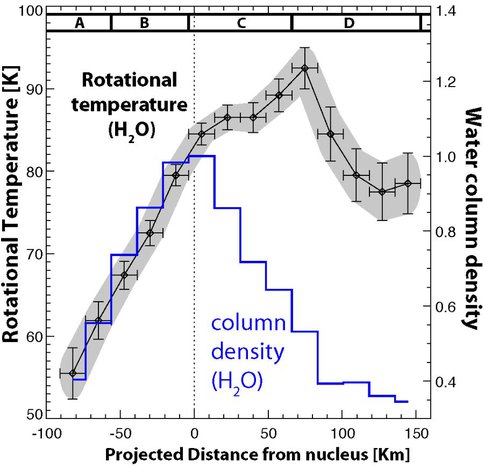2012 Annual Science Report
 NASA Goddard Space Flight Center
Reporting | SEP 2011 – AUG 2012
NASA Goddard Space Flight Center
Reporting | SEP 2011 – AUG 2012
Composition of Parent Volatiles in Comets
Project Summary
During the period covered by this progress report we observed the Oort cloud comets C/2009 (Garradd) and C/2010 G2 (Hill). We completed our comprehensive study of prebiotic molecules in comet C/2007 N3 (Lulin). We continued our multi-comet surveys of spin temperatures and searches for deuterated species. We conducted spatially-resolved measurements of water rotational temperature, column abundance, and ortho-para ratio in the inner coma of comet 103P/Hartley 2 – the target of NASA the EPOXI fly-by mission. We studied the volatile composition of another Jupiter-family comets – 21P/Giacobini-Zinner. We studied the activity of comet Christensen beyond 3 AU from the Sun.
Project Progress
1. The nature of volatile release in comet 103P/Hartley-2
We acquired high-resolution near-infrared spectra of H2O emission from comet 103P/Hartley-2 using NIRSPEC at Keck 2. Using long-slit spectroscopy we directly probed the inner coma of Hartley 2 via spectrally and spatially resolved measurements of rotational temperature, column abundance, and ortho-para ratio.
Contribution: These measurements are a “window” to conditions in the inner (collisionally-dominated) cometary coma. Our quantitative view of these conditions has been mostly indirect. It depends strongly on model predictions that are constrained by measurements (in situ and remote) taken only at much larger nucleocentric distances (>1000 km) and later extrapolated to infer near-nucleus conditions. However, our spatial studies of rotational temperature, abundance, and ortho-para ratio of water in comet 103P/Hartley 2 provided direct constraints on both molecular excitation and volatile release in the inner coma. These constraints are critical for accurate determination of abundances of cometary volatiles, including prebiotic molecules. The technique of measuring a spatial distribution of temperature was substantially improved compared to our earlier study of Schwassmann-Wachmann 3B (Bonev et al. 2008).
2. Unusual abundances of prebiotic molecules in comet C/2007 N3 (Lulin)
We detected nine parent volatiles (H2O, HCN, CH4, C2H2, C2H6, CH3OH, C2H2, H2CO, and NH3) and two product species (OH and NH2) in Comet C/2007 N3 (Lulin) using high-dispersion infrared spectroscopy.
Contribution: The ortho-para ratio (OPR) of water was 3.17 ± 0.12, corresponding to nuclear spin temperature Tspin > 45 K. The A:E:F ratio of spin states for CH4 corresponds to a Tspin > 60 K. Coupled with the upper limits of HDO/H2O (< 3.6 VSMOW) and CH3D/CH4 < 2.9%, we suggest that Lulin's volatiles formed under warm (> about 50 K) temperatures. In comparison with other comets we found that HCN and H2CO were depleted, C2H6 and CH4, close to current mean among observed comets, while CH3OH was substantially enriched. Such prebiotic volatile chemistry is not common based on previous observations of comets. It illustrates the importance of continuing studies of these molecules in comets (and other space environments) in order to better understand the synthesis of the more complex prebiotic compounds.
Fig. 1: Spatial distribution of water column density and rotational temperature in comet 103P/Hartley 2, observed near closest approach to Earth (UT October 22, 2012). The rotational temperatures revealed pronounced asymmetry while the column densities were nearly symmetric about the nucleus. We suggest this dichotomy reflects two qualitatively different mechanisms of volatile release (slow icy clumps vs. fast icy grains), which introduce distinct rotational distributions in the sublimated material.
Fig. 2: Comparison of abundance ratios (% relative to water) for the most commonly measured volatiles (in the infrared) among comets. All abundances are relative to the cometary mean (see Villanueva et al. 2011b). Squares represent comet C/2001 A2 (Magee-Sauer et al. 2008), the comet defining “organics-rich”. A similarly enriched comet (C/2007 W1 Boattini) is shown by diamonds (Villanueva et al. 2011b). Comet C/1999 S4 (blue asterisks; Mumma et al. 2001) represents the most systematically organics depleted comet observed to date. These comets define the current approximate range of abundances for most species (CO excepted). Red triangles connected by a red line show the abundances for Lulin. Note the more extreme variation from “enhanced” to “depleted” abundances for molecules in Lulin compared to the consistently “enhanced” or “depleted” comets.
Publications
-
Fougere, N., Combi, M. R., Tenishev, V., Rubin, M., Bonev, B. P., & Mumma, M. J. (2012). Understanding measured water rotational temperatures and column densities in the very innermost coma of Comet 73P/Schwassmann–Wachmann 3 B. Icarus, 221(1), 174–185. doi:10.1016/j.icarus.2012.07.019
-
Gibb, E. L., Bonev, B. P., Villanueva, G., DiSanti, M. A., Mumma, M. J., Sudholt, E., & Radeva, Y. (2012). CHEMICAL COMPOSITION OF COMET C/2007 N3 (LULIN): ANOTHER ‘‘ATYPICAL’’ COMET. The Astrophysical Journal, 750(2), 102. doi:10.1088/0004-637x/750/2/102
-
Paganini, L., Mumma, M. J., Villanueva, G. L., DiSanti, M. A., Bonev, B. P., Lippi, M., & Boehnhardt, H. (2012). THE CHEMICAL COMPOSITION OF CO-RICH COMET C/2009 P1 (GARRADD) AT R h = 2.4 and 2.0 AU BEFORE PERIHELION. The Astrophysical Journal, 748(1), L13. doi:10.1088/2041-8205/748/1/l13
-
Villanueva, G. L., Mumma, M. J., DiSanti, M. A., Bonev, B. P., Paganini, L., & Blake, G. A. (2012). A multi-instrument study of Comet C/2009 P1 (Garradd) at 2.1AU (pre-perihelion) from the Sun. Icarus, 220(1), 291–295. doi:10.1016/j.icarus.2012.03.027
-
PROJECT INVESTIGATORS:
-
PROJECT MEMBERS:
Boncho Bonev
Co-Investigator
-
RELATED OBJECTIVES:
Objective 2.2
Outer Solar System exploration
Objective 3.1
Sources of prebiotic materials and catalysts

